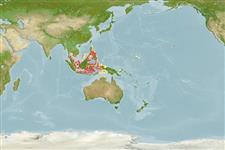>
Blenniiformes (Blennies) >
Blenniidae (Combtooth blennies) > Salariinae
Etymology: Ecsenius: Greek, exenios, -os, -on = uncontrolled, immoderate; tricolor: Name from the Latin 'tri-' meaning 3, and 'color', referring to the three stripes on the head; noun in apposition.
Environment: milieu / climate zone / depth range / distribution range
Ecologia
marinhas demersal; intervalo de profundidade 1 - 10 m (Ref. 48636). Tropical
Western Central Pacific: Philippines and Borneo.
Tamanho / Peso / Idade
Maturity: Lm ? range ? - ? cm
Max length : 6.0 cm TL macho/indeterminado; (Ref. 48636)
Descrição suscinta
Chaves de identificação | Morfologia | Morfometria
Has a distinctive blue-white line below the eye that usually continues over the axil to above the anus on the body, bordered by a bright orange one below over the gill section. Head deep blue, continuing and gradually changing on the body to bright orange on the tail (Ref. 48636).
Adults inhabit seaward and sheltered reefs (Ref. 90102). They occur in coral rich habitats at about 10 m depth, usually among Acropora branches (Ref. 48636). Oviparous. Eggs are demersal and adhesive (Ref. 205), and are attached to the substrate via a filamentous, adhesive pad or pedestal (Ref. 94114). Larvae are planktonic, often found in shallow, coastal waters (Ref. 94114).
Ciclo de vida ou comportamento de acasalamento
Maturidade | Reprodução | Desova | Ovos | Fecundidade | Larvas
Oviparous, distinct pairing (Ref. 205).
Springer, V.G. and G.R. Allen, 2001. Ecsenius ops, from Indonesia, and E. tricolor, from western Philippines and northwestern Kalimantan, new species of blenniid fishes in the stigmatura species group. aqua, J. Ichthyol. Aquat. Biol. 4(4):151-160. (Ref. 55736)
Status na Lista Vermelha da UICN (Ref. 130435: Version 2024-2)
Ameaça para os humanos
Harmless
Uso pelos humanos
Ferramentas
Relatórios especiais
Baixar XML
Fontes da internet
Estimates based on models
Preferred temperature (Ref.
123201): 28.5 - 29.3, mean 28.8 °C (based on 721 cells).
Índice de diversidade filogenética (Ref.
82804): PD
50 = 0.5000 [Uniqueness, from 0.5 = low to 2.0 = high].
Bayesian length-weight: a=0.00776 (0.00356 - 0.01695), b=3.00 (2.81 - 3.19), in cm total length, based on LWR estimates for this (Sub)family-body shape (Ref.
93245).
Nível Trófico (Ref.
69278): 2.0 ±0.00 se; based on food items.
Resiliência (Ref.
120179): Elevada, tempo mínimo de duplicação da população menor que 15 meses (Preliminary K or Fecundity.).
Fishing Vulnerability (Ref.
59153): Low vulnerability (10 of 100).
